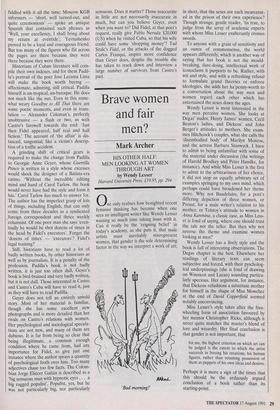Brave women and fair men?
Mark Archer
HIS OTHER HALF: MEN LOOKING AT WOMEN THROUGH ART by Wendy Lesser Harvard University Press, £19.95, pp. 294 One only realises how benighted recent feminist thinking has become when one sees an intelligent writer like Wendy Lesser wasting so much time taking issue with it. Can it really be the 'reigning belief' in today's academy, as she puts it, that male artists must inevitably misrepresent women, that gender is the sole determining factor in the way we interpret a work of art; Tad morning!' in short, that the sexes are each incarcerat- ed in the prison of their own experience? Though strange, gentle reader, 'tis true, to judge from the array of academic experts with whom Miss Lesser exuberantly crosses swords. • To anyone with a grain of sensitivity and an ounce of commonsense, the world appears differently, which is another way of saying that her book is not the mould- breaking, dare-doing, intellectual work of iconoclasm it purports to be. Rather, with wit and style, and with a refreshing refusal to formulate grand theories or enforce ideologies, she \ adds her ha'penny-worth to a conversatio about the way men and women regarc4 each other which has entertained the sexes down the ages.
Wendy Lesser is most interested in the way men perceive women. She looks at Degas' nudes, Henry James' women, Cecil Beaton's ladies, and Dickens' and John Berger's attitudes to mothers. She exam- ines Hitchcock's couples, what she calls the 'disembodied body' of Marilyn Monroe, and the actress Barbara Stanwyck. I have to admit to being unfamiliar with some of the material under discussion (the writings of Harold Brodkey and Peter Handke, for instance). And while Miss Lesser is the first to admit to the arbitrariness of her choice, it did not stop an equally arbitrary set of examples springing to my own mind, which perhaps could have broadened her theme more. Why not Baudelaire, for a poet's differing depiction of three women, or Proust, for a male writer's relation to his mother, or Tolstoy's attitude to women in Anna Karenina, a classic case, as Miss Less- er is fond of saying, where one should trust the tale not the teller. But then why not reverse the theme and examine women looking at men?
Wendy Lesser has a lively style and the book is full of interesting observations. The Degas chapter is the best. Elsewhere her readings of literary texts can seem subjective and forced, with their pyscholog- ical underpinnings (she is fond of drawing on Winnicot and Lacan) sounding particu- larly specious. Her argument, for instance, that Dickens refashions a substitute mother for himself in the shape of Miss Mowcher at the end of David Copperfield seemed notably unconvincing.
Miss Lesser's style takes after the free- wheeling form of association favoured by her mentor Christopher Ricks, although it never quite matches the master's blend of lore and wizardry. Her final conclusion is that gender is not important, that
for me, the highest criterion on which art can be judged is the extent to which the artist succeeds in freeing his creations, his human figures, rather than retaining possession of them as puppets of his own ideas and desires.
Perhaps it is more a sign of the times that this should be the arduously argued conclusion of a book rather than its starting-point.


















































 Previous page
Previous page